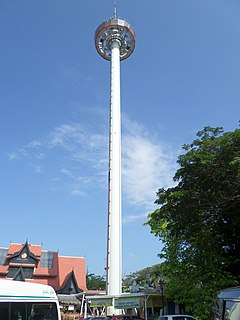
The Malacca Sultanate was a Malay sultanate centred in the modern-day state of Malacca, Malaysia. Conventional historical thesis marks c. 1400 as the founding year of the sultanate by an Parameswara King of Singapore, Parameswara, also known as Iskandar Shah(after converted to Islam). At the height of the sultanate's power in the 15th century, its capital grew into one of the most important transshipment ports of its time, with territory covering much of the Malay Peninsula, the Riau Islands and a significant portion of the northern coast of Sumatra in present-day Indonesia.

The kris or keris in the Indonesian and Malay languages, is an asymmetrical dagger with distinctive blade-patterning achieved through alternating laminations of iron and nickelous iron (pamor). Of Javanese origin, the kris is famous for its distinctive wavy blade, although many have straight blades as well, and is one of the weapons commonly used in the pencak silat martial art native to Indonesia.

Hang Tuah was a warrior who lived in Malacca during the reign of Sultan Mansur Shah in the 15th century. He was supposedly the most powerful of all the laksamana, or admirals, and is considered by the Malays to be one of history's greatest silat masters. Hang Tuah is held in the highest regard, even in present-day Malay culture, and is arguably the most well-known and illustrious warrior figure in Malay history and literature.

Hang Jebat was the closest companion of the legendary Malaccan hero Hang Tuah. Regarded in Malaysia as one of the greatest silat exponents in history, he is well known for his vengeful rebellion against the Malacca Sultan whom he served. He can also be regarded as an early Malay anarchist following his rebellion against the ruler.

Puteri Gunung Ledang is a 2004 Malaysian epic fantasy period film directed by Saw Teong Hin. The film is based on the Malay legend of the Gunung Ledang princess, who is said to have lived on top of Gunung Ledang, and a Malaccan sultan's effort to court her. The film stars Tiara Jacquelina, M. Nasir and Adlin Aman Ramlie.

Bendahara is an administrative position within classical Malay kingdoms comparable to a vizier before the intervention of European powers during the 19th century. A bendahara was appointed by a sultan and was a hereditary post. The bendahara and the sultan shared the same lineage.
Sultan Mahmud Shah ibni Almarhum Sultan Alauddin Riayat Shah ruled the Sultanate of Malacca from 1488 to 1511, and again as pretender to the throne from 1513 to 1528.

Bendahara Paduka Raja Tun Perak was the fifth and most famous bendahara, a Malay rank similar to a prime minister, of the Sultanate of Malacca. He served under four sultans from 1456 to 1498. Early in his life, Perak was a soldier-statesman for Malaccan rulers. In 1445, he led the Malaccan army to victory by defeating Siamese invaders. As a result, he was made bendahara in 1456.

The Sultan of Perak is one of the oldest hereditary seats among the Malay states.
Laksamana Hang Nadim was a warrior of the Johor-Riau during the Portuguese occupation of Malacca. He is the son of legendary Malacca Warrior Hang Jebat and foster son another legendary Malacca Warrior Hang Tuah. After the fall of Malacca to the Portuguese in 1511, Sultan Mahmud withdrew from Teloh Naming to Ulu Muar, then settled in Pagoh and Bentayan. Sultan Mahmud and his descendants built up the Johor Sultanate as the basis of Johor-Riau Empire based in Johore, the Riau Islands, Pahang and all those parts of the old Malacca Sultanate which was not occupied by the Portuguese. Although Malacca had fallen to the Portuguese, Sultan Mahmud and his son Sultan Ahmad had continuously sent his army to attack the Portuguese in Malacca from 1511 till 1526. Sultan Mahmud died in Kampar, Sumatra in 1528 and was known as Marhum Kampar.

Sungai Udang is a mukim in Central Malacca, Malacca, Malaysia. It is situated within the parliamentary constituency of Tangga Batu. It have another name call which is "Home of Commander".

Puteri Gunung Ledang is a Malaysian musical directed by Zahim Albakri, co-directed by Adlin Aman Ramlie, book by Adlin Aman Ramlie, Saw Teong Hin and Zahim Al-Bakri and music composed by Dick Lee. The musical is based on the 2004 Puteri Gunung Ledang film. The original production was staged at the Istana Budaya in February 2006, this was followed by two more productions and an upcoming third in February 2009. Tiara Jacquelina and Stephen Rahman-Hughes starred as Gusti Putri and Hang Tuah in all the productions to date. Other members of the production team are music director Roslan Aziz, choreographer Pat Ibrahim and production designer Raja Malek. The musical was staged in poetic Malay and Javanese-accented Malay, but English subtitles were provided.

Puteri Gunong Ledang is a 1961 Malay period film directed by S. Roomai Noor and based on the Legend of Puteri Gunung Ledang. The film introduces actress Elaine Edley in her first film role.
The regalia of Malaysia includes all the items which are deemed sacred and symbolic of the supremacy and authority of the Yang di-Pertuan Agong or the Supreme King of Malaysia and his consort, the Raja Permaisuri Agong. The installation of the Supreme King is a very special ceremony. Only on this particular day are the masses able to see his regalia. Several of these are Malaysian National Treasures since 2009.
Sultan Ahmad Shah ibni Almarhum Sultan Mahmud Shah was the last sultan of the Malaccan sultanate.

Tun Datuk Seri Utama Dr. Mohd Khalil bin Yaakob is the former Yang di-Pertua Negeri (Governor) of the Malaysian state of Melaka. Khalil is a United Malays National Organisation (UMNO) politician from Pahang, and served as the state's Menteri Besar for more than 10 years. He was appointed as governor in 2004 by the Yang di-Pertuan Agong.

The Legend of Hang Tuah is a 1956 Singaporean historical drama film directed by Phani Majumdar. It is the first Malay film to be fully shot in Eastman colour film. It was released to public on 28 January 1956. The film was based on the legendary Admiral Hang Tuah of Malacca and his 4 sworn brothers; Hang Jebat, Hang Kasturi, Hang Lekir and Hang Lekiu. This film received the award for 'Best Musical Score' at the 3rd Asian Film Festival in Hong Kong in 1956 and an official screening at 7th Berlin International Film Festival in 1957, where it was nominated for the Golden Bear.
Sri Maharaja Sang Sapurba Paduka Sri Trimurti Tri Buana, (1245–1316) also known as Sri Nila Pahlawan, is a figure in the Malay Annals, highly revered as the legendary great ancestor of some of the major dynasties of the Malay world: Singapura, Malacca, Pahang, Johor, Perak, Kelantan, Terengganu and Siak Sri Indrapura. Legend has it that after his accession to Seguntang Hill with his two younger brothers, Sang Sapurba enters into a sacred covenant with Demang Lebar Daun the native ruler of Palembang, which laid the basis of the proper relationship between the Malay rulers and the subjects. The legendary sword believed to be carried by the king, the Cura Si Manjakini, is now formed part of the regalia of Perak Sultanate, whose rulers are said directly descended from the king. The details of Sang Sapurba stories are mainly composed of folklore and legends, and thus his historical existence is debated and disputed by modern historians. Even so, as De Jong argued in her article The Character of Malay Annals, the stories of the Malay Annals could have been realistically mixed with the historical figures and events.

Istiadat Pewaris Penjurit-Kepetangan Melayu or formerly known as Ilmu Persilatan Penjurit-Kepetangan Melayu, shortform IPPM is one of the oldest original known to date Malay martial art form or called 'Silat' in existence which has been heritage from one generation to another. Descended from the first ruler of the Malayapura Kingdom, King Adityawarman whom is also known as Seri Maharaja Diraja which to a later stage sparked the start of Minangkabau history in Pagaruyung Kingdom, Sumatra, Indonesia. These story has been greatly narrated in most of old Malay Literature including in of the most reliable sources to date called Sulalatus al-Salatin or better known as The Malay Annals (Malay: Sejarah Melayu). The manuscript begin with the stories of Wan Malini and Wan Empuk whom was presented with 3 adopted princes right after when their rice fields was magically expelling gold. These 3 princes was later mark as the kickstart for the next 3 big empires in Malay Archipelago. Those empires were the Kingdom of Majapahit, The Malacca Sultanate and the Pagaruyung Kingdom around the 12th century.

The Taming Sari Tower is a revolving gyro tower in Malacca City, Malaysia.















